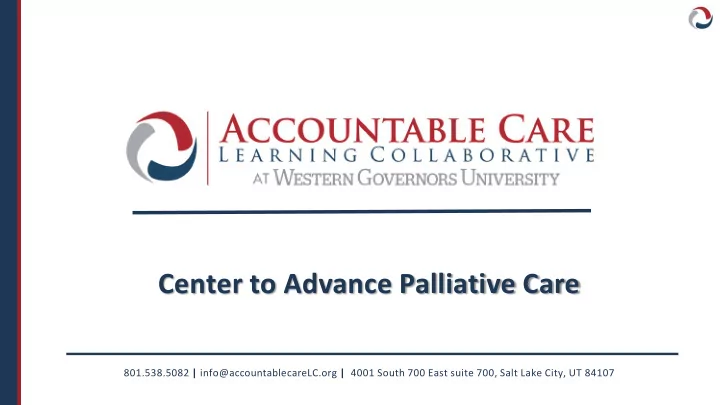

Center to Advance Palliative Care 801.538.5082 | info@accountablecareLC.org | 4001 South 700 East suite 700, Salt Lake City, UT 84107
HOUSEKEEPING • To minimize feedback, please mute your line If you are using both a phone and computer, it is best to dial in • first, then through your computer and select the “connect via audio” option when the window pops up, then mute your phone • There will be several opportunities for questions. Please submit them using the Zoom question box • Just a few announcements from the ACLC
AGENDA ACLC updates • Introduction of guest presenters • The Benefits of Palliative Care by Dr. Diane • Meier, CAPC Palliative Care in Action by Dr. Daniel Hoefer, • Sharp Healthcare Opportunity for Q&A • Members can submit questions ahead of time by using the – question box of the Zoom window
UPCOMING MEMBER EVENT(S) ACLC Member Meeting at HIMSS17 Orlando, FL February 20 th Co-located with the HIMSS17 Annual Conference • Members of the ACLC are invited to attend a second Healthcare Conference day on Tuesday, • February 21st hosted by Leavitt Partners Look for registration links in weekly news every Tuesday
THE BENEFITS OF PALLIATIVE CARE IN VALUE-BASED PROGRAMS Diane E. Meier, MD Director, Center to Advance Palliative Care Daniel Hoefer, MD CMO Palliative Medicine Sharp Healthcare
GUEST PRESENTER Dr. Diane Meier Director, Center to Advance Palliative Care Icahn School of Medicine at Mount Sinai
WHAT IS PALLIATIVE CARE? An added layer of support for quality of life - relief of pain, symptoms and stresses of serious illness Provided by an interdisciplinary team that works closely not only with treating physicians, but also with family caregivers Appropriate at any age and any stage of a serious illness Should be provided concurrent with disease treatment
MR. B An 88 year old man with • dementia admitted via the ED for management of back pain due to prostate cancer, spinal stenosis and arthritis. Pain is 8/10 on admission, • for which he is taking 5,000 mg of acetaminophen/day. Admitted 3 times in 2 • months for pain (2x), falls, and altered mental status due to constipation. His family (83 year old wife) • is overwhelmed.
MR B: BEFORE AND AFTER Usual Care Palliative Care 4 calls to 911 in a 3 month period, House calls referral • • leading to Pain management • 4 ED visits and • 24/7 phone coverage • 3 hospitalizations, leading to: • Support for caregiver • – Hospital acquired infection Meals on Wheels • – Functional decline Friendly visitor program • – Family distress No 911 calls, ED visits, or • hospitalizations in last 18 months
WHO BENEFITS FROM PALLIATIVE CARE? • Cancer Functional • Advanced liver • 911 Calls Limitations disease • Emergency • COPD with oxygen • Limitations in Department visits Activities of Daily • CHF, Stroke • Hospital admissions Living (eating, • Trauma • Skilled nursing and bathing, dressing, • Renal failure rehab stays toileting, • Dementia • Home nursing transferring and and/or rehab • Diabetes with severe walking) complications • Exhausted family • ALS caregivers Serious illness High Utilization • Frailty Graphic adapted from the National Consensus Project for Quality Palliative Care
Costliest 5% of Patients IOM Dying in America Report Appendix E http://www.iom.edu/Reports/2014/Dying-In-America-Improving-Quality-and-Honoring-Individual- Preferences-Near-the-End-of-Life.aspx Only a small portion of these 11% patients are in the last year of life. 40% Focus on end-of-life Last 12 months of life and prognosis misses the big Short term high $ 49% opportunity for Improvement. Persistent high $
EARLY AND CONCURRENT PALLIATIVE CARE MAKES A DIFFERENCE . . . Randomized trial simultaneous standard cancer care with palliative care co-management from diagnosis versus control group receiving standard cancer care only: – Improved quality of life – Reduced major depression – Reduced ‘aggressiveness’ (less chemo < 14d before death, more likely to get hospice, less likely to be hospitalized in last month) – Improved survival (11.6 mos. vs 8.9 mos., p<0.02) Temel et al. Early palliative care for patients with non-small-cell lung cancer NEJM2010;363:733-42.
. . . AND LEADS TO COST AVOIDANCE Setting Results Studies Inpatient $1,696 costs saved per admission for (Morrison, 2008) Hospital live discharges; $4,908 for death Palliative Care 43% fewer ICU admissions (Gade, 2008) Office-Based In Primary Care: 20% fewer hospital (Trisolini 2006) Palliative Care admissions $117/day in oncology practice (Greer 2016) Home-Based 33% lower costs ($117.50 savings/day) (Brumley 2007) Primary and Palliative Care 36% lower costs in ACO model ($12,000 (Lustbader 2016) saved per patient) Commercial 22% lower medical costs (Krakauer 2009) Health Insurer ($12,000 saved per member on Program program)
THE 5 KEY CHARACTERISTICS OF EFFECTIVE PALLIATIVE CARE • Target the highest risk people • Ask people what matters most to them, and modify their care accordingly ( Advance Health Care Planning ) • Ensure proactive pain/symptom management ( Proactive Medical Management ) • Support family and other caregivers ( Proactive Management ) • Provide 24/7 access 14
GUEST PRESENTER Dr. Daniel R Hoefer CMO Palliative Medicine Sharp Healthcare
SHARP TRANSITIONS PROGRAM: TARGET THE HIGHEST RISK PEOPLE • Experiencing functional decline • Hospitalization or ED visit due to advanced chronic illness • Examples – CHF NYHA stage 3 or greater – COPD FEV1 <35%; on home oxygen – Dementia FAST 5 score; assistance with IADLs 16
SHARP TRANSITIONS PROGRAM: HOW IT WORKS Care Team RN, MSW, Physician and Spiritual Care Services Active Phase 4-6 weeks of home visits with patient/family RN averages 6 visits; MSW 1-2 visits Maintenance Phase Regular phone communication/coordination, visits as needed; preparing for the future… eventually hand off to hospice
SHARP TRANSITIONS PROGRAM: FOUR PILLARS ENSURE EFFECTIVE CARE
SHARP TRANSITIONS OUTCOMES: HOSPITAL + ED UTILIZATION
SHARP TRANSITIONS OUTCOMES: TOTAL COST OF CARE
Q & A
Questions About the ACLC? If you have questions about the ACLC please email members@accountablecarelc.org
801.538.5082 | info@accountablecareLC.org | 4001 South 700 East suite 700, Salt Lake City, UT 84107
Recommend
More recommend